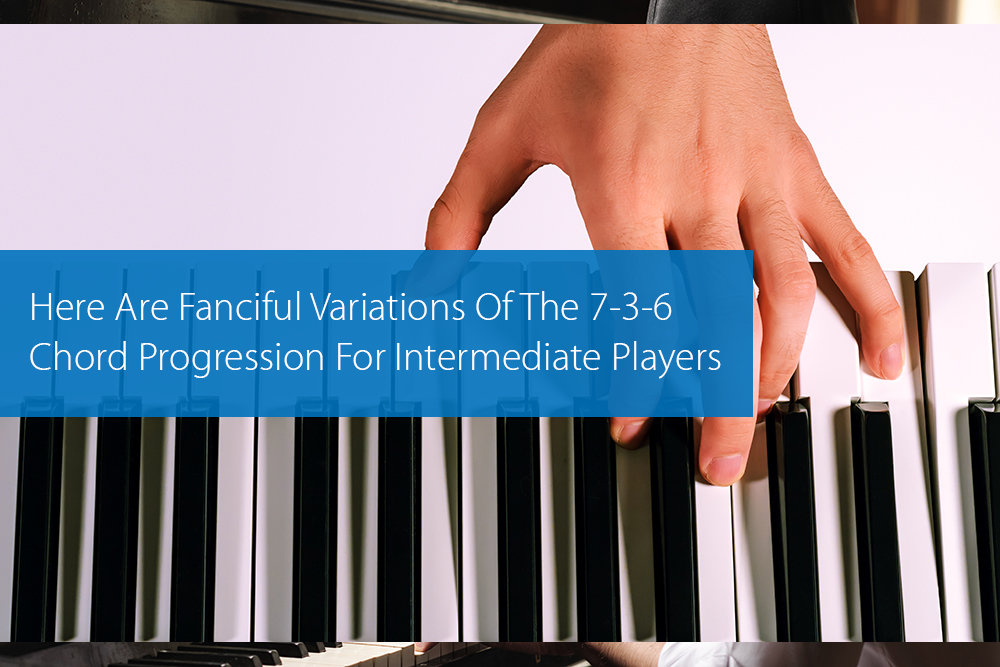
In today’s lesson, you’ll be learning fanciful variations of the 7-3-6 chord progression.
Attention: This lesson is written with the intermediate level piano player in mind. However, pre-advanced players can also find the chord progressions helpful.
Before we go into the fanciful progressions, let’s talk about the 7-3-6 chord progression
A Short Note On The 7-3-6 Chord Progression
There are two key types in tonal music – the major key and the minor key.
Every key has eight degrees. In the key of C major:
C is the first degree
D is the second degree
E is the third degree
F is the fourth degree
G is the fifth degree
A is the sixth degree
B is the seventh degree
C is the eight degree
The movement of chords from one degree of the scale to another produces a chord progression. So, a 7-3-6 chord progression is basically a chord progression from the seventh tone to the third tone, then to the sixth tone.
In the key of C major:
…this implies a root progression from B (the seventh tone):
…to E (the third tone):
…then to A (the sixth tone):
“Check Out The 7-3-6 Chord Progression In The Key Of C Major…”
Chord 7:
…the B half-diminished seventh chord.
Chord 3:
…the E dominant seventh (flat nine) chord:
Chord 6:
…the A minor ninth chord.
Fanciful Variations Of The 7-3-6 Chord Progression
It’s important for every serious pianist to know the basic 7-3-6 chord progression. Beyond the basic 7-3-6 chord progression, there are fanciful variations that are commonly applied in jazz and gospel music and I’ll be sharing them with you.
In this segment, you’ll learn a variety of extended chords, rootless chords, altered chords, etc., that can give you a spicier 7-3-6 chord progression.
Attention: All examples are in the key of C major.
Variation #1
Over B:
…which is the seventh tone, is the rootless voicing of the B dominant thirteenth (sharp eleven) chord:
Over E:
…which is the third tone, is the rootless voicing of the E dominant seventh (sharp nine, sharp five) chord:
Over A:
…which is the sixth tone, is the rootless voicing of the A minor eleventh chord:
Variation #2
Over B:
…which is the seventh tone, is the B minor eleventh chord:
Over E:
…which is the third tone, is the E dominant seventh (sharp nine, sharp five) chord:
Over A:
…which is the third tone, is the A minor eleventh chord:
Variation #3
Over B:
…which is the seventh tone, is the B dominant seventh (flat nine) chord:
Over E:
…which is the third tone, is the E dominant seventh (flat nine) chord:
Over A:
…which is the sixth tone, is the A minor eleventh chord:
Variation #4
Over B:
…which is the seventh tone, is the B dominant seventh (sharp nine, sharp five) chord:
Over E:
…which is the third tone, is the E dominant seventh (sharp nine, sharp five) chord:
Over A:
…which is the sixth tone, is the A minor eleventh chord:
5.
Over B:
…which is the seventh tone, is the B dominant thirteenth (flat nine) chord:
Over E:
…which is the third tone, is the E dominant seventh (flat nine) chord:
Over A:
…which is the sixth tone, is the A dominant thirteenth (suspended fourth) chord:
Final Words
Congratulations! I’m doubly sure you’ve sophisticated your chordal arsenal. I recommend the transposition of these 7-3-6 chord progressions to other keys on the keyboard.
See you in the next lesson.
Chuku Onyemachi
Latest posts by Chuku Onyemachi (see all)
- The Formation Of Diminished Seventh Chords Used To Be Challenging Until I Did This
- How To Form Seventh Chords In Two Shakes Of A Dog’s Tail Using Third Intervals And The Circle Of Fifths Chart
- I Played The 13sus4 Chord And This Happened…
- How To Build Seventh Chords Like An Architect Using “Foundation And Structure” Concept
- This 4-Week Plan Will Help You Master All The Major Scales







Comments on this entry are closed.